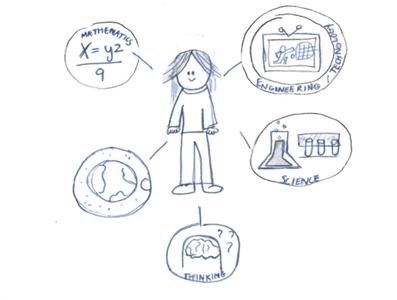A Picture is Worth a Thousand Words: Examining learners’ illustrations to understand Attitudes towards Mathematics
DOI:
https://doi.org/10.31273/eirj.v2i2.113Keywords:
visual data, images/drawings, case study, attitudes, affect, cognitionAbstract
This article presents my experience of using pictures/images drawn by children as a form of data in research and discusses the merits and implications of employing this method. It comes from research of a mixed method exploratory case study to investigate the attitudes of 11 and 15 year old secondary school students (in the East Midlands) towards Mathematics. The aim of this research was to gain an insight into the emotions, cognition, beliefs and behaviour of learners regarding Maths and the factors which influence their attitude. Besides using the tried and tested data collection tools such as focus groups and questionnaires, the children were asked to draw pictures illustrating their vision of Maths and its impact on their lives. The idea was to offer them an alternative medium of communication to exhibit their feelings and thoughts. Students used emoticons, numerals, figures, characters and mathematical symbols to show their favourable/unfavourable attitudes towards Maths and their understanding of the importance of Maths in future life. The results of visual data in this study conform to the findings of the other forms of data collected and show that boys and higher ability students have a more positive attitude towards Mathematics as compared to girls and low ability students.
Downloads
References
Anning, A. (2002), ‘Conversations around young children’s drawing: The impact of the beliefs of significant others at home and school’, Journal of Art and Design Education, 21(3),197–208
A summary of the UN Convention on the Rights of the Child (1989). http://www.unicef.org.uk/Documents/Publication-pdfs/UNCRC_PRESS200910web.pdf accessed on 22 December, 2014
Barbour, R. (2008), Introducing Qualitative Research: A Student's Guide to the Craft of Doing Qualitative Research, UK: Open University Press.
Bekhit, N. S, Thomas, G. V. & Jolley, R. P. (2005), ‘The use of drawing for psychological assessment in Britain: Survey findings’, Psychology and Psychotherapy: Theory, Research and Practice, 78, 205–217
Berg, B. L. (2009), Qualitative Research Methods: For the Social Science, Boston: Pearson Education Inc.
Burkitt, E., Barrett, M. & Davis, A. (2003b), ’The effect of affective characterisations on the use of colour within children’s drawings’, Journal of Child Psychology and Psychiatry, 44, 445–455.
Burkitt, E. (2004), ‘Drawing conclusions from children’s art’, The Psychologist, 17, 566-568.
Carey, M. (2011), The social work dissertation: Using Small-Scale Qualitative Methodology, New York: Open University Press
Cox, S. (2005), ‘Intention and Meaning in Young Children’s Drawing’, International Journal of Art & Design Education, 24(2), 115–125
Durrani, N. (2008), ‘Schooling the ‘other’: the representation of gender and national identities in Pakistani curriculum texts’, A Journal of Comparative and International Education, 38:5, 595-610
Einarsdottir, J., Dockett, S. & Perry, B. (2009), ‘Making meaning: children’s perspectives expressed through drawings’, Early Child Development and Care, 179:2, 217-232
Henderson, N.R. (1995), ‘A practical approach to analysing and reporting focus groups studies: lessons from qualitative market research’, Qualitative Health Research 5, 463-477
MacPhail, A. & Kinchin, G. (2004), ‘The use of drawings as an evaluative tool: students' experiences of sport education’, Physical Education and Sport Pedagogy. Available at: http://dx.doi.org/10.1080/1740898042000208142 Accessed on 15 October, 2014.
Malchiodi, C. (1998), Understanding Children’s Drawings, New York: The Guilford Press
Merriman, B. & Guerin, S. (2012), ‘Using Children’s Drawings as Data in Child-Centred Research’, The Irish Journal of Psychology, 27 (1-2), 48-57.
Sim, J. (1998), ‘Collecting and analysing qualitative data: issues raised by the focus group’, Journal of Advanced Nursing, 28(2), 345-352
Smith, C. (2011). Proceedings of the British Society for Research into Learning Mathematics (Ed.) 31(1) Available at: www.bsrlm.org.uk Accessed on 6 June, 2014
Thomas, G. V. & Jolley, R. P. (1998), ‘Drawing conclusions: a re-examination of drawings’, Journal of Clinical Psychology, 37, 127–139.

Published
Issue
Section
License
Authors who publish with this journal agree to the following terms:
Authors retain copyright and grant the journal right of first publication with the work simultaneously licensed under a Creative Commons Attribution License (CC-BY), which permits use and redistribution of the work provided that the original author and source are credited, a link to the license is included, and an indication of changes which were made. Third-party users may not apply legal terms or technological measures to the published article which legally restrict others from doing anything the license permits.
If accepted for publication authors’ work will be made open access and distributed under a Creative Commons Attribution (CC-BY) license unless previously agreed with Exchanges’ Editor-in-Chief prior to submission.
Authors are able to enter into separate, additional contractual arrangements for the non-exclusive distribution of the journal's published version of the work (e.g., post it to an institutional repository or publish it in a book), with an acknowledgement of its initial publication in this journal.
Authors are permitted and encouraged to post their work online (e.g., in institutional repositories or on their website) prior to and during the submission process, as it can lead to productive exchanges, as well as earlier and greater citation of published work. (see: The Effect of Open Access)
